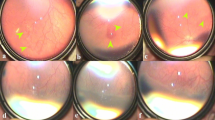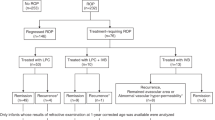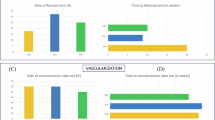Abstract
Purpose
To evaluate the refractive outcomes in children treated after intravitreal injection of bevacizumab (IVB) for retinopathy of prematurity (ROP).
Methods
A retrospective, bi-centre study of 34 patients (64 eyes) was conducted. The patients were divided into three groups, patients received intravitreal IVB (IVB group), patients received combined IVB and laser treatment (IVB+Laser group), or patients received lens-sparing vitrectomy (IVB+LSV group). Cycloplegic refraction and axial length (AXL) were evaluated at 2 years old.
Results
The prevalences of myopia and high myopia were 47.5 and 10.0% in the IVB group, respectively, which were lower than those in the IVB+Laser (82.4 and 29.4%) and IVB+LSV (all 100%) groups (P=0.001 and P<0.001). The prevalences of emmetropia in the IVB group, IVB+Laser group, and IVB+LSV group were 50, 5.9, and 0% (P=0.001). The AXL were similar among all groups.
Conclusions
At the 2-year follow-up, severe ROP patients treated with IVB alone were more likely to remain emmetropic and had lower prevalences of myopia and high myopia. The development of high myopia in severe ROP patients could not be explained by AXL changes but may be associated with abnormalities in the anterior segment.
Similar content being viewed by others
Log in or create a free account to read this content
Gain free access to this article, as well as selected content from this journal and more on nature.com
or
References
Gilbert C, Fielder A, Gordillo L, Quinn G, Semiglia R, Visintin P et al. Characteristics of infants with severe retinopathy of prematurity in countries with low, moderate, and high levels of development: implications for screening programs. Pediatrics 2005; 115: e518–e525.
Early treatment for retinopathy of prematurity cooperative group. Revised indications for the treatment of retinopathy of prematurity: results of the early treatment for retinopathy of prematurity randomized trial. Arch Ophthalmol 2003; 121: 1684–1694.
Axer-Siegel R, Maharshak I, Snir M, Friling R, Ehrlich R, Sherf I et al. Diode laser treatment of retinopathy of prematurity: anatomical and refractive outcomes. Retina 2008; 28: 839–846.
Dhawan A, Dogra M, Vinekar A, Gupta A, Dutta S . Structural sequelae and refractive outcome after successful laser treatment for threshold retinopathy of prematurity. J Pediatr Ophthalmol Strabismus 2008; 45: 356–361.
Quinn GE, Dobson V, Kivlin J, Kaufman LM, Repka MX, Reynolds JD et al. Prevalence of myopia between 3 months and 5 1/2 years in preterm infants with and without retinopathy of prematurity. Cryotherapy for Retinopathy of Prematurity Cooperative Group. Ophthalmology 1998; 105: 1292–1300.
Sahni J, Subhedar NV, Clark D . Treated threshold stage 3 versus spontaneously regressed subthreshold stage 3 retinopathy of prematurity: a study of motility, refractive, and anatomical outcomes at 6 months and 36 months. Br J Ophthalmol 2005; 89: 154–159.
Algawi K, Goggin M, O'Keefe M . Refractive outcome following diode laser versus cryotherapy for eyes with retinopathy of prematurity. Br J Ophthalmol 1994; 78: 612–614.
Mintz-Hittner HA, Kennedy KA, Chuang AZ . Efficacy of intravitreal bevacizumab for stage 3+ retinopathy of prematurity. N Engl J Med 2011; 364: 603–615.
Harder BC, von BS, Schlichtenbrede FC, Jonas JB . Early refractive outcome after intravitreous bevacizumab for retinopathy of prematurity. Arch Ophthalmol 2012; 130: 800–801.
Harder BC, Schlichtenbrede FC, von BS, Jendritza W, Jendritza B, Jonas JB . Intravitreal bevacizumab for retinopathy of prematurity: refractive error results. Am J Ophthalmol 2013; 155: 1119–1124.
Castellanos MA, Schwartz S, Garcia-Aguirre G, Quiroz-Mercado H . Short-term outcome after intravitreal ranibizumab injections for the treatment of retinopathy of prematurity. Br J Ophthalmol 2013; 97: 816–819.
Tseng CC, Chen SN, Hwang JF, Lin CJ . Different refractive errors in triplets with retinopathy of prematurity treated with bevacizumab. J Pediatr Ophthalmol Strabismus 2012; 49: e41–e43.
Section on Ophthalmology American Academy of Pediatrics; American Academy of Ophthalmology; American Association for Pediatric Ophthalmology and Strabismus. Screening examination of premature infants for retinopathy of prematurity. Pediatrics 2006; 117: 572–576.
An international classification of retinopathy of prematurity. The Committee for the Classification of Retinopathy of Prematurity. Arch Ophthalmol 1984; 102: 1130–1134.
Good WV . Final results of the Early Treatment for Retinopathy of Prematurity (ETROP) randomized trial. Trans Am Ophthalmol Soc 2004; 102: 233–248.
Repka MX . Refraction and keratometry in premature infants. Br J Ophthalmol 2004; 88: 853–854.
Martinez-Castellanos MA, Schwartz S, Hernandez-Rojas ML, Kon-Jara VA, García-Aguirre G, Guerrero-Naranjo JL et al. Long-term effect of antiangiogenic therapy for retinopathy of prematurity up to 5 years of follow-up. Retina 2013; 33: 329–338.
Chen TC, Tsai TH, Shih YF, Yeh PT, Yang CH, Hu FC et al. Long-term evaluation of refractive status and optical components in eyes of children born prematurely. Invest Ophthalmol Vis Sci 2010; 51: 6140–6148.
Wu WC, Lin RI, Shih CP, Wang NK, Chen YP, Chao AN et al. Visual acuity, optical components, and macular abnormalities in patients with a history of retinopathy of prematurity. Ophthalmology 2012; 119: 1907–1916.
van Heuven WA, Kiel JW . ROP surgery and ocular circulation. Eye (Lond) 2008; 22: 1267–1272.
Holz ER . Refractive outcomes of three-port lens-sparing vitrectomy for retinopathy of prematurity (An AOS Thesis). Trans Am Ophthalmol Soc 2009; 107: 300–310.
Holmström M, el Azazi M, Kugelberg U . Ophthalmological long-term follow up of preterm infants: a population based, prospective study of the refraction and its development. Br J Ophthalmol 1998; 82: 1265–1271.
Acknowledgements
The authors have no proprietary interest in any aspect of this study and received no government funding.
Author information
Authors and Affiliations
Corresponding author
Ethics declarations
Competing interests
The authors declare no conflict of interest.
Rights and permissions
About this article
Cite this article
Chen, YH., Chen, SN., Lien, RI. et al. Refractive errors after the use of bevacizumab for the treatment of retinopathy of prematurity: 2-year outcomes. Eye 28, 1080–1087 (2014). https://doi.org/10.1038/eye.2014.172
Received:
Accepted:
Published:
Issue date:
DOI: https://doi.org/10.1038/eye.2014.172
This article is cited by
-
Outcomes of near confluent laser versus combined less dense laser and bevacizumab treatment of prethreshold ROP Type 1 Zone 2: a randomized controlled trial
BMC Ophthalmology (2022)
-
Refractive status, biometric components, and functional outcomes of patients with threshold retinopathy of prematurity: systemic review and a 17-year longitudinal study
Graefe's Archive for Clinical and Experimental Ophthalmology (2022)
-
Predictors and ocular outcomes of rescue treatment in preterm infants with treated retinopathy of prematurity—a retrospective study
Eye (2021)
-
Retinopathy of prematurity treatment: Asian perspectives
Eye (2020)
-
Neurodevelopmental outcomes in infants treated with intravitreal bevacizumab versus laser
Journal of Perinatology (2019)



